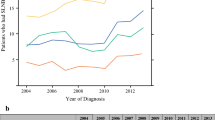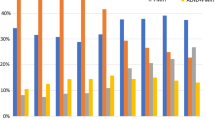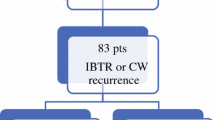Abstract
Background
Population-based overall patterns of surgical management of the axilla in women with operable breast cancer during the era of adoption of sentinel lymph node biopsy (SLNB) were studied.
Methods
Women with operable breast carcinoma residing in 14 geographic areas of the Surveillance, Epidemiology, and End Results (SEER) cancer registries (1998–2004, n = 239,661) were assessed for axillary surgical patterns of care.
Results
Use of SLNB increased from 11 to 59%. Use of no axillary surgery decreased from 14 to 6.6%. In pathologic node-negative women, use of axillary lymph node dissection (ALND) decreased from 94 to 36%. Independent factors most associated with failure to receive SLNB included diagnosis year (2000: 62%; 2004: 29%), surgery (mastectomy: 64%; breast-conserving surgery: 36%), tumor size (T3: 71%; T2: 56%; T1: 40%), age (≥70 years: 50%; <70 years: 45%), grade (high: 42%; low: 38%), urbanity (non-large metropolitan area: 49%; large metropolitan area: 42%), and, by quartile, poverty (highest: 47%; lowest: 35%), and white-collar employment (lowest: 56%; highest: 47%). In pathologic node-positive women who had SLNB, failure to undergo completion ALND increased from 20% in 1998 to 32% in 2004. Patients with smaller, lower-grade tumors, and those with smaller size of nodal metastasis, lack of extracapsular extension, age ≥70 years, increased linguistic isolation, African-American or Hispanic race/ethnicity, and white-collar employment were less likely to undergo completion ALND.
Conclusions
Management of the axilla changed dramatically during the period of rapid adoption of SLNB. Patterns of care suggest both appropriate and inappropriate selection for SLNB and ALND.

Similar content being viewed by others

References
Nemoto T, Vana J, Bedwani RN, et al. Management and survival of female breast cancer: results of a national survey by the American College of Surgeons. Cancer. 1980;45(12):2917–24.
Foster RS, Jr. The biologic and clinical significance of lymphatic metastases in breast cancer. Surg Oncol Clin North Am. 1996;5(1):79–104.
Giuliano AE, Kirgan DM, Guenther JM, Morton DL. Lymphatic mapping and sentinel lymphadenectomy for breast cancer. Ann Surg. 1994;220(3):391–8; discussion 398–401.
Krag DN, Weaver DL, Alex JC, Fairbank JT. Surgical resection and radiolocalization of the sentinel lymph node in breast cancer using a gamma probe. Surg Oncol. 1993;2(6):335–9; discussion 340.
Mansel RE, Fallowfield L, Kissin M, et al. Randomized multicenter trial of sentinel node biopsy versus standard axillary treatment in operable breast cancer: the ALMANAC Trial. J Natl Cancer Inst. 2006;98(9):599–609.
Veronesi U, Paganelli G, Viale G, et al. A randomized comparison of sentinel-node biopsy with routine axillary dissection in breast cancer. N Engl J Med. 2003;349(6):546–53.
Surveillance, Epidemiology, and End Results (SEER) Program (www.seer.cancer.gov) Limited-Use Data (1973–2004), National Cancer Institute, DCCPS, Surveillance Research Program, Cancer Statistics Branch, released April 2007, based on the November 2006 submission.
Surveillance Research Program, National Cancer Institute SEER*Stat software (www.seer.cancer.gov/seerstat) version 6.2.4, Accessed Jan 7, 2008.
Zhang J, Yu KF. What’s the relative risk. A method of correcting the odds ratio in cohort studies of common outcomes. JAMA. 1998;280(19):1690–1.
Keynes G. Conservative treatment of cancer of the breast. BMJ. 1937;2(4004):643–7.
Baclesse F. Roentgen therapy as the sole method of treatment of cancer of the breast. Am J Roentgenol Radium Ther Nucl Med. 1949;62(3):311–9.
Peters MV. Carcinoma of the breast Stage II-radiation range Wedge resection and irradiation. An effective treatment in early breast cancer. JAMA. 1967;200(2):134–5.
Levene MB, Harris JR, Hellman S. Treatment of carcinoma of the breast by radiation therapy. Cancer. 1977;39(6 Suppl):2840–5.
Early Breast Cancer Trialists’ Collaborative Group (EBCTG). Effects of radiotherapy and of differences in the extent of surgery for early breast cancer on local recurrence and 15-year survival: an overview of randomized trials. Lancet. 2005;366(9503):2087–106.
NIH Consensus Development Conference on the Treatment of Early-Stage Breast Cancer. Bethesda, Maryland, June 18–21, 1990. J Natl Cancer Inst Monogr. 1992;(11):1–187.
Lazovich D, Solomon CC, Thomas DB, et al. Breast conservation therapy in the United States following the 1990 National Institutes of Health Consensus Development Conference on the treatment of patients with early stage invasive breast carcinoma. Cancer. 1999;86(4):628–37.
Krag D, Weaver D, Ashikaga T, et al. The sentinel node in breast cancer—a multicenter validation study. N Engl J Med. 1998;339(14):941–6.
Fisher B. From Halsted to prevention and beyond: advances in the management of breast cancer during the twentieth century. Eur J Cancer. 1999;35(14):1963–73.
Cady B. Lymph node metastases. Indicators, but not governors of survival. Arch Surg. 1984;119(9):1067–72.
Schwartz GF, Giuliano AE, Veronesi U. Proceedings of the consensus conference on the role of sentinel lymph node biopsy in carcinoma of the breast, April 19–22, 2001, Philadelphia, Pennsylvania. Cancer. 2002;94(10):2542–51.
Veronesi U, Paganelli G, Viale G, et al. Sentinel-lymph-node biopsy as a staging procedure in breast cancer: update of a randomised controlled study. Lancet Oncol. 2006;7(12):983–90.
Krag DN, Anderson SJ, Julian TB, et al. Technical outcomes of sentinel lymph node resection and conventional axillary-lymph-node dissection in patients with clinically node-negative breast cancer: results from the NSABP B–32 randomised phase III trial. Lancet Oncol. 2007;8(10):881–8.
Barone JE, Tucker JB, Perez JM, Odom SR, Ghevariya V. Evidence-based medicine applied to sentinel lymph node biopsy in patients with breast cancer. Am Surg. 2005;71(1):66–70.
Bembenek A, Fischer J, Albrecht H, et al. Impact of patient- and disease-specific factors on SLNB in breast cancer patients. Are current guidelines justified? World J Surg. 2007;31(2):267–75.
Lelievre L, Houvenaeghel G, Buttarelli M, et al. Value of the sentinel lymph node procedure in patients with large size breast cancer. Ann Surg Oncol. 2007;14(2):621–6.
Lyman GH, Giuliano AE, Somerfield MR, et al. American Society of Clinical Oncology guideline recommendations for sentinel lymph node biopsy in early-stage breast cancer. J Clin Oncol. 2005;23(30):7703–20.
Garreau JR, Nelson J, Cook D, et al. Geographic variation in sentinel node adaptation by practicing surgeons in Oregon. Am J Surg. 2005;189(5):616–6; discussion 619–20.
Conn CA, McMasters KM, Edwards MJ, Martin RC. Acceptance of sentinel lymph node biopsy of the breast by all general surgeons in Kentucky. Breast J. 2005;11(4):231–5.
Chua B, Olivotto IA, Donald JC, Hayashi AH, Davis N, Rusnak CH. Practice patterns of lymph-node mapping and sentinel-node biopsy for breast cancer in British Columbia. Can J Surg. 2003;46(4):273–8.
Chen AY, Halpern MT, Schrag NM, Stewart A, Leitch M, Ward E. Disparities and trends in sentinel lymph node biopsy among early-stage breast cancer patients. J Natl Cancer Inst. 2008;100(7):462–74.
Wong JS, Taghian AG, Bellon JR, et al. Tangential radiotherapy without axillary surgery in early-stage breast cancer: results of a prospective trial. Int J Radiat Oncol Biol Phys. 2008; in press.
Schlembach PJ, Buchholz TA, Ross MI, et al. Relationship of sentinel and axillary level I-II lymph nodes to tangential fields used in breast irradiation. Int J Radiat Oncol Biol Phys. 2001;51(3):671–8.
Park J, Fey JV, Naik AM, Borgen PI, Van Zee KJ, Cody HS 3rd. A declining rate of completion axillary dissection in sentinel lymph node-positive breast cancer patients is associated with the use of a multivariate nomogram. Ann Surg. 2007;245(3):462–8.
Hwang RF, Gonzalez-Angulo AM, Yi M, et al. Low locoregional failure rates in selected breast cancer patients with tumor-positive sentinel lymph nodes who do not undergo completion axillary dissection. Cancer. 2007;110:723–30.
Rescigno J, Taylor LA, Aziz MS, et al. Predicting negative axillary lymph node dissection in patients with positive sentinel lymph node biopsy: can a subset of patients be spared axillary dissection? Breast Cancer Res Treat. 2005;94(Supp 1):S35–6.
Degnim AC, Reynolds C, Pantvaidya G, et al. Nonsentinel node metastasis in breast cancer patients: assessment of an existing and a new predictive nomogram. Am J Surg. 2005;190:543–50.
Hughes KS, Schnaper LA, Berry D, et al. Lumpectomy plus tamoxifen with or without irradiation in women 70 years of age or older with early breast cancer. N Engl J Med. 2004;351:971–7.
Veronesi U, Orecchia R, Zurrida S, et al. Avoiding axillary dissection in breast cancer surgery: a randomized trial to assess the role of axillary radiotherapy. Ann Oncol. 2005;16(3):383–8.
Author information
Authors and Affiliations
Corresponding author
Rights and permissions
About this article
Cite this article
Rescigno, J., Zampell, J.C. & Axelrod, D. Patterns of Axillary Surgical Care for Breast Cancer in the Era of Sentinel Lymph Node Biopsy. Ann Surg Oncol 16, 687–696 (2009). https://doi.org/10.1245/s10434-008-0195-5
Received:
Revised:
Accepted:
Published:
Issue Date:
DOI: https://doi.org/10.1245/s10434-008-0195-5



